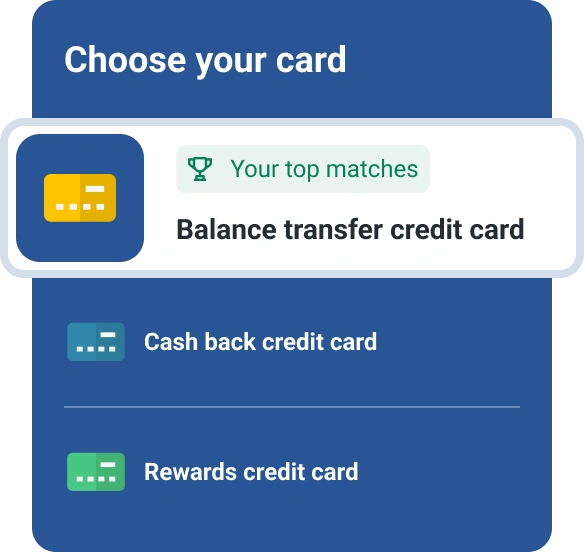How to Avoid Balance Transfer Fees on Your Credit Card
Quick Answer
To avoid balance transfer fees, find a credit card that doesn’t charge these fees. If you can’t find one, choose the best balance transfer card by comparing fees, promotional terms and standard interest rates to figure out how much you can save.

Are you struggling to pay off high credit card balances? A balance transfer credit card offering a low or 0% introductory annual percentage rate (APR) on transferred balances could make debt easier to pay off. However, you'll typically pay a balance transfer fee, usually 3% to 5% of the amount transferred.
You can avoid a balance transfer fee by choosing a card that doesn't charge this type of fee. These cards can be hard to find; the next best thing is to look for a card with a low balance transfer fee.
How Balance Transfer Fees Work
Balance transfer fees typically range from 3% to 5% of the amount transferred. For example, if you transferred a $5,000 balance to a card with a 3% balance transfer fee, you'd pay $150. If the card had a 5% fee, you'd pay $250. Some cards charge one balance transfer fee for transfers completed by a certain date after opening an account and a different fee for transfers completed later.
In addition to credit card debt, you can sometimes use a balance transfer card to pay off loans, such as personal loans or home equity lines of credit (HELOCs). When you request a balance transfer, the card issuer may pay the lender of the transferred debt directly or send you a check so you can pay it off.
The amount transferred, plus any balance transfer fee, becomes the balance on your new card. If you transferred $2,000 to a card with a 5% balance transfer fee, for example, the initial balance on that card would be $2,100.
Are Balance Transfer Fees Worth It?
A balance transfer fee can be worth it if the balance transfer fee is small compared with the amount you can save on interest by making the transfer. For example, suppose you get a balance transfer card offering a 0% introductory APR for 21 months with a 5% balance transfer fee. Transfer a $5,000 balance to the card, and you'd pay $250 in balance transfer fees.
The total balance on your new card would be $5,250. Pay $250 per month toward the card, and you'd pay off the balance in 21 payments without incurring any additional interest.
What if you don't do a balance transfer, but continue paying $250 per month toward the $5,000 balance on your original credit card? Assuming that card's APR is 20.68% (the average as of May 2023, according to the Federal Reserve), you'd spend 25 months and $1,133 in interest paying off the balance. Choosing the balance transfer card would save you $883, even after subtracting the $250 balance transfer fee.
To save that much on interest, of course, you must pay off your transferred balance before the promotional period ends. At that point, any remaining balance accrues interest at your new card's standard APR. This could reduce or even cancel out the potential savings from the balance transfer.
Before choosing a balance transfer card, consider its other costs and benefits, such as annual fees or rewards. Depending on how much you plan to transfer, a card with a $99 annual fee and a 3% balance transfer fee could cost more than a card with a 3% balance transfer fee but no annual fee.
How to Avoid Balance Transfer Fees
The only way to avoid a balance transfer fee is to choose a card that doesn't charge one. You can shop around and look for a balance transfer card with no fee, but they tend to be few and far between. (Sometimes your existing card issuer will give you a balance transfer offer that doesn't involve a balance transfer fee; however, these cards rarely feature a 0% introductory APR.)
If you can't find a card without a balance transfer fee, compare various cards' balance transfer fees, as well as the following factors:
- Other fees: Annual fees, late fees or foreign transaction fees can add up if you travel a lot or occasionally forget to pay your bills on time.
- Length of the low or 0% introductory APR: Longer promotional periods can make it easier to pay off a large balance before the introductory APR ends.
- The standard APR: What will your APR be after the promotional period ends? If you plan to keep using the card—or if you can't pay off your balance within the introductory period—a lower APR will save money on interest.
- Time limits on balance transfers: Some cards require transferring your balance within 45 days of opening an account to qualify for the low APR. Others give you several months, which offers more flexibility.
- Low or 0% introductory APRs on purchases: Some balance transfer cards offer promotional APRs on purchases as well as balance transfers.
- Rewards: Rewards shouldn't be your primary focus when consolidating debt with a balance transfer card. However, if the other features of two cards are equal, consider choosing the one with better perks.
Best Practices for Completing a Balance Transfer
You've chosen a balance transfer card and been approved. To make a balance transfer, follow these steps.
- Know both the introductory APR and the ongoing APR, which any remaining or new balance will incur after the promotional period ends.
- Check to see how much time you have to complete the balance transfer. It may take several weeks for a transfer to complete, so if there's a short window of time (such as 45 days) to get the promotional APR, you'll need to act fast.
- List the balance, APR, creditor and account number for each debt you want to transfer. Add up the balances.
- Find out what your credit limit and balance transfer limits are, keeping in mind that any balance transfer fee will be added to your total. Some card issuers let you transfer a balance up to your credit limit; others restrict you to smaller transfers based on their policies or your creditworthiness. If your limit won't allow transferring all your debt, transfer the balances with the highest APRs.
- Request a balance transfer from the new card issuer. Be ready to provide information about the debts you're transferring, such as your account number, your outstanding balance and the name of the creditor.
- Wait for the new card issuer to pay off the debt. You may get a check or deposit to your bank account that you can use to pay off your other creditors, or the card issuer may pay them directly and move the debt to your balance transfer card.
- Make sure your transfer is completed. Keep making payments on the debts you transferred until you're sure the transfer is complete and have confirmed that your old cards or loans have zero balances. Even if a transfer is in process, a late payment on your old accounts will appear on your credit report and could negatively affect your credit score.
- Understand the card's terms. Check the details of your new cardholder agreement. For example, will a late payment cost you your introductory APR or cause an even higher penalty APR to kick in?
- Begin paying off your new balance. Divide your new balance by the number of months or billing cycles in the promotional period. Pay that amount each month to pay off your balance before your 0% introductory APR ends.
The Bottom Line
Getting approved for a balance transfer card typically requires good or excellent credit, which is a FICO® ScoreΘ of 670 and above. Before applying for a balance transfer card, check your credit report and credit score. Bringing late accounts current and paying bills on time can help improve your credit score. So can signing up for Experian Boost®ø, a free feature that adds on-time utility, cellphone, streaming service and eligible rent payments to your Experian credit report to quickly boost your FICO® Score powered by Experian data.
Best balance transfer cards
Need to consolidate debt and save on interest? See if you qualify for intro offers like 0% intro APR up to 21 months based on your FICO® Score.
See your offersAbout the author
Karen Axelton specializes in writing about business and entrepreneurship. She has created content for companies including American Express, Bank of America, MetLife, Amazon, Cox Media, Intel, Intuit, Microsoft and Xerox.
Read more from Karen

